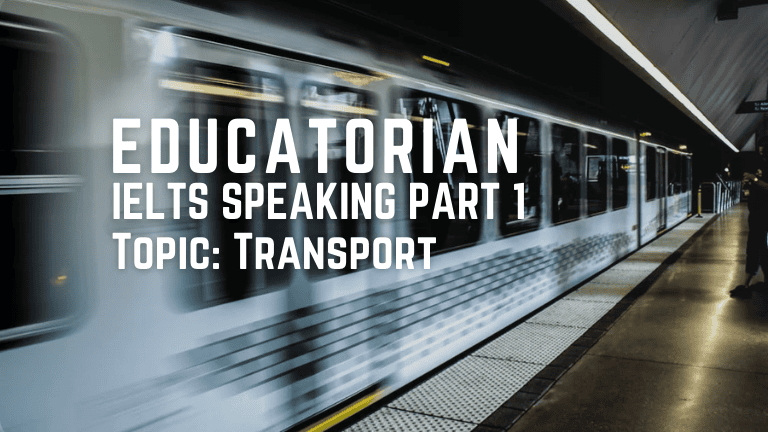
IELTS Speaking Part 1 – Transport
IELTS Speaking Part 1 (Transport)
Topic: Transport
Difficulty: Easy
IELTS Speaking Part 1 – Transport
- What are the advantages of using public transport?
- Do most young people prefer to take public transport to school or to work?
- Which means of transport is expensive?
- Which means of transport is convenient?
What are the advantages of using public transport?
Aya (High School Student)
– “Um, I think, public transport is good because, uh, it’s cheap and many people can use it. In Japan, we have, um, trains and buses that are very, uh, reliable. I also think it helps the environment because, um, fewer cars are on the road. If I use the train, I don’t have to, um, worry about traffic or parking, which is, uh, very helpful. But sometimes, it can be, uh, crowded, especially during rush hour, so it’s, um, not always comfortable. Still, it’s, um, better for students like me because it’s easy and cheap.”
Minho (University Student)
– “I think public transport has many advantages. First, it’s quite affordable for students and young people. In Korea, the subway system is really convenient because it’s fast, and you can avoid traffic. You don’t have to worry about parking, which is a big problem if you drive. It’s also eco-friendly because, you know, fewer cars on the road means less pollution. One downside, though, is that during peak times, it can be really crowded, and sometimes it’s hard to find a seat. But overall, I think it’s a good option for getting around, especially for people without a car.”
Linh (Office Worker)
– “Public transport offers several advantages, particularly for people living in cities. First of all, it’s cost-effective, especially when compared to owning and maintaining a car. For example, in Vietnam, the bus system is much cheaper than paying for fuel, parking, and repairs. It also helps reduce traffic congestion, which can be a huge issue in big cities. Another important benefit is that public transport is better for the environment, as it lowers the number of individual vehicles on the road. However, the service can sometimes be unreliable, and delays are not uncommon, but overall, it’s a practical choice for many people.”
Mr. Wong(Retired English Teacher)
– “The advantages of public transport are numerous, particularly in urban areas. Public transportation is both cost-efficient and environmentally sustainable, reducing the need for individual car usage, which in turn reduces carbon emissions. Furthermore, it promotes accessibility, allowing a wide range of people, including students, the elderly, and those without cars, to navigate the city. In many large cities, public transport systems are well-organized and punctual, making them a convenient option. However, it’s important to note that the quality of public transport can vary from place to place, but overall, it plays a crucial role in ensuring mobility for all.”
Do most young people prefer to take public transport to school or to work?
Aya (High School Student)
– Um, in Japan, I think many young people, like high school students, use public transport. Uh, we usually take the train or bus to school because, um, it’s easy and, uh, cheap. In the cities, almost all students, uh, use trains because it’s, uh, too far to walk or bike. Also, we don’t, um, have cars, so we need to use public transport. I think it’s, uh, common for students to take it because, um, driving is not allowed for, uh, people my age. So, yes, we, uh, prefer it.”
Minho (University Student)
– “Yeah, I think a lot of young people in Korea, especially students, prefer to use public transport. It’s easy and very efficient. Many university students, like me, use the subway or buses to get to school. We don’t really need cars because the public transport system is reliable and fast. Also, getting a car and paying for parking is expensive, especially for students. I think young people don’t mind using it, and even if they could drive, they’d probably still choose public transport because it’s more practical.”
Linh (Office Worker)
– “In Vietnam, many young people, especially those in cities, tend to use motorbikes more than public transport, but there is a growing number who prefer buses, especially university students or young professionals. It’s affordable and can save them money compared to the cost of owning a motorbike or car. That said, I believe there’s a cultural preference for motorbikes because they’re faster and more convenient in terms of getting around traffic. Still, public transport is becoming more popular, particularly among students who might not have their own vehicle yet.”
Mr. Wong(Retired English Teacher)
– “In general, I think it depends on where the young people are living. In more urbanized areas, young people certainly prefer public transport to get to school or work, especially if it’s convenient and well-organized. In places where the transport system is reliable, it eliminates the need for owning a car, which can be costly for students or young professionals. However, in more rural areas or places with less developed systems, they might rely more on personal vehicles. But in most large cities, public transport is the go-to option for young people.”
Which means of transport is expensive?
Aya (High School Student)
– “Um, I think, in Japan, owning a car is, uh, expensive. You need to pay for, um, gas, parking, and, uh, insurance. Also, the parking in cities is, um, very expensive, and sometimes, uh, hard to find. So, many people, um, prefer to use public transport because it’s, um, cheaper. For students like me, it’s, uh, better to take the train or bus because we don’t, um, have to pay so much. I think owning a car is, um, expensive in Japan.”
Minho (University Student)
– “In Korea, I think owning a car can be quite expensive. You have to pay for gas, insurance, and maintenance, which can add up quickly. Parking is also really expensive, especially in the city. That’s why a lot of young people don’t own cars until they’re older. Public transport is much cheaper in comparison. Even taxis can be expensive if you use them regularly. So, I’d say, overall, cars are the most expensive form of transport here.”
Linh (Office Worker)
-“I would say that in Vietnam, cars are definitely one of the most expensive means of transport. The cost of purchasing a car, along with fuel, parking fees, and maintenance, makes it a luxury for many people. Additionally, the taxes on cars can be quite high. Most people, especially young professionals and students, find motorbikes or public transport more affordable. While motorbikes are much cheaper than cars, even they can become expensive if you factor in repairs and fuel costs over time.”
Mr. Wong(Retired English Teacher)
– “Globally, owning a car is generally one of the most expensive modes of transport. The costs are not just limited to purchasing the vehicle itself but also extend to fuel, insurance, parking, and maintenance. In some cities, even the taxes and tolls for driving can make it quite costly. Comparatively, public transport is far more affordable. Additionally, in some urban centers, car ownership is more of a burden due to the lack of parking and heavy traffic, which further emphasizes the expense.”
Which means of transport is convenient?
Aya (High School Student)
– “Um, I think the train is, uh, very convenient in Japan. The trains are, uh, on time and you can go to, um, many places quickly. Also, they come, um, very often, so you don’t have to, uh, wait for long. For students, it’s, um, easy because we don’t have to, um, worry about driving or parking. I think, um, trains and buses are convenient for, uh, people who live in cities.”
Minho (University Student)
– “In Korea, I think the subway is the most convenient. It’s fast, reliable, and you don’t have to worry about traffic jams. The stations are everywhere, and you can easily switch between subway lines to get around the city. Even buses are convenient because they cover areas where the subway doesn’t reach. So, I think public transport, especially the subway, is the best option for convenience.”
Linh (Office Worker)
– “In terms of convenience, motorbikes are incredibly popular in Vietnam. They allow people to navigate through the traffic quickly, and you don’t need to worry about parking as much as with cars. However, in cities where traffic congestion can be a problem, public transport, like buses, is also quite convenient for getting around without dealing with the hassle of driving. So, both motorbikes and buses offer different kinds of convenience.”
Mr. Wong(Retired English Teacher)
– “The convenience of a particular mode of transport depends on the setting. In most large cities, public transport, such as subways or buses, tends to be the most convenient because it avoids the complications of driving, such as parking and traffic. In some places, cycling or even walking can be highly convenient, particularly in areas designed for pedestrian traffic. Overall, for day-to-day urban travel, public transport is often the most convenient choice.”
Check other collections here.
Check my personal website here

Ian Tanpiuco is an ESL and virtual assistant. With a decade of experience, he has become an expert in his field. Dedicated to helping others achieve their goals, Ian works tirelessly in the classroom or as a virtual assistant.

